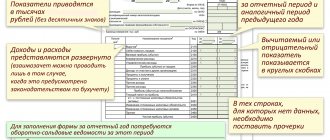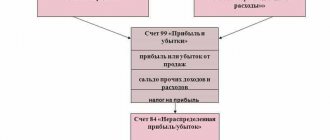Issues discussed in the material:
- What is the net profit indicator and why is it needed?
- How to calculate the net profit of an organization
- How is net profit reflected in financial statements?
- What is the difference between net and retained earnings
Net profit and running a business are inextricably linked. New companies are opened precisely to generate income, entrepreneurs actively use material and labor resources, and develop ways to increase the profitability of the business. Therefore, it is important for any businessman to understand such a concept as net profit. The formula for its calculation with examples is the topic of our material.
What is net profit?
Commerce is inextricably linked with the concept of net profit. To get it, people found new enterprises, open production facilities, and constantly look for effective ways to increase the company’s income, and not only the owners and managers of companies are interested in maximizing net profit.
Net profit is one of the main final indicators of the activity of any business entity. This indicator includes the entire balance sheet profit of the company, from which the amounts of expenses (for staff salaries, managerial, production and others), taxes, fees and other contributions to the budget are subtracted.
The net profit belongs to the enterprise in full; it can be managed by renewing the company's funds from it, paying interest to shareholders, and expanding working capital. That is, this money can be spent on expanding the business, covering current needs, introducing innovations, updating equipment, etc.
Any enterprise regularly faces the need to calculate the amount of net profit, but the criteria for assessing the effectiveness of business management differ in different companies. Among them the main ones are:
- capital turnover;
- economic efficiency;
- increase in assets.
By calculating the company's net profit, we can accurately determine how much money remains in the ownership of the business entity.
Calculating the amount of net profit is also necessary for non-profit organizations (state-owned, budgetary, etc.), since the concept of operational efficiency is applicable to them as well.
A direct indication of the legislation regulating the work of Limited Liability Companies (LLC) and Joint Stock Companies (JSC) prescribes that net profit should be directed to:
- payment of dividends to shareholders (or distribution among members of the company);
- business development, increasing the volume of working capital;
- other company needs.
Thus, it is important for the accounting department of any joint stock company to know how to calculate net profit and also to pay dividends in full and correctly.
We recommend
“Calculating Enterprise Profit: A Complete Guide for Beginners” Read more
Distribution
The procedure for distribution of profits is regulated by the company's charter and is divided according to the distributed shares of the participants. To distribute net profit, you first need to organize a meeting of company participants, and only after making a general decision to pay money to each participant. If there is only one participant, for example, an individual entrepreneur, then he independently decides where the net profit received will be directed.
Net profit can be used to:
- Creation of a social and investment fund;
- Increase the authorized capital;
- Formation of reserve capital;
- Payment of dividends to security holders.
Video on the topic:
Difference between net and retained earnings
Net income is not synonymous with retained earnings (although some believe that they are the same thing). They often differ quantitatively, are calculated differently and are recorded in accounting documents.
To reflect net profit, there is a separate line in the organization’s financial results statement. Each enterprise is required to calculate and record net profit at the end of the reporting period. Sometimes there is no profit as such, things are going badly, and then instead, a loss is reflected in the final documents.
Recommended articles on this topic:
- Pricing methods and recommendations for their use
- Doing business: from developing a plan to choosing software
- Methods for reducing costs in a company and enterprise without small sacrifices
Retained earnings are recorded elsewhere - in the liabilities side of the balance sheet.
As a rule, the term “net profit” refers to the income received by a subject of economic relations during the reporting period (usually a calendar year). Retained earnings include income not only for the current year, but also for previous periods.
Let's look at an elementary practical example of how you can calculate the net profit of a store. The balance sheet of Vasilek LLC at the very beginning of the year, January 1, contains in the “retained earnings” column the amount of 3.2 million rubles, and the net profit for this year is equal to 750 thousand rubles. Thus:
- Retained earnings at the beginning of the reporting period - 3,200 million rubles.
- Net profit for the reporting year is 750 thousand rubles.
- Retained earnings at the end of the reporting year - 3.950 million rubles.
That is, the company’s net profit is always calculated for a specific reporting period, and retained earnings (instead of which there is sometimes a loss) represents the result of the company’s work from the moment of its opening, for the entire time.
In what cases is it prohibited to distribute profits?
Profits are distributed in accordance with the decision made at the meeting of the LLC. However, in some cases, profits cannot be spent at your own discretion. Consider these cases:
- The authorized capital has not been fully paid.
- The participant who leaves the LLC is not transferred funds in the amount of his share.
- There are signs of bankruptcy. This is relevant even if bankruptcy proceedings are not carried out against the enterprise.
- If the money is spent, the company will show signs of bankruptcy.
- The amount of net assets (that is, the funds remaining after paying all taxes and other obligatory payments) should not be less than 10,000 rubles. This is the minimum limit specified by law.
ATTENTION! The general director is responsible for ensuring compliance with all these rules. In case of violations, responsibility will fall on him.
Why calculate net profit?
The amount of net profit measures the efficiency of the entire enterprise. This parameter is required for various purposes by both external and internal stakeholders.
| User/stakeholder | Purpose and uses |
| Investor | Assess the investment attractiveness of the business. To do this, analyze the amount of net profit and the dynamics of its changes. The ability of a company to produce a large net profit at the end of the reporting period indicates its high profitability |
| Creditor | Assessing the company's creditworthiness. It is determined by the amount and dynamics of net profit, on which the solvency and creditworthiness of the organization depends. Money is the most liquid asset. The more free capital a company has after paying taxes and all inevitable costs, the easier it will be for it to pay off long-term and short-term obligations |
| Business owner or shareholder | Assess the effectiveness of the organization as a whole. An integral characteristic of an organization’s activities is net profit, which reflects the effectiveness of all management decisions made in the reporting period. The larger it is, the more efficient the management, the greater the dividend payments and the easier it is to attract new shareholders and sell company shares. |
| Provider | Assess the stability of the organization's functioning. Suppliers are interested in net profit as a marker of the sustainable development of the client company: the more significant net income it received during the reporting period, the more it can be counted on to pay suppliers on time for purchased materials and raw materials, as well as fulfill obligations to contractors |
| Top manager | Assess the stability of the company's financial development. The manager of an enterprise is interested in the amount of net profit and its dynamics as guidelines for developing strategies and planning further activities - from global to very specific plans and schedules. It is also necessary to calculate net profit to distribute contributions to various funds: production, salary, reserve |
We recommend
“Types of company profit: what are they and how to calculate” Read more
Nuances of the cost structure when calculating costs
Material costs. Which would seem simpler. However, practice is very different from ideal theory. To understand how much, an entrepreneur just needs to look at the wording of payments on the current account and try to tell how to correctly account for a particular transaction. So, the following expenses are not included in the cost price:
- Advance payments for the purchase of inventory items. Including those that will be subsequently used in the main production process. Prepayments for services are also not considered.
- Repayment of loans and payment of previously received loans can significantly reduce the actual profitability of the company, but are not considered cost.
- Payment for participation in the capital of other companies (through, for example, the purchase of shares or interests) cannot be attributed to the cost of the production process.
- Large-scale invoicable purchases such as the purchase of equipment and other fixed assets for your own company are not the cost of currently manufactured products.
Taking into account these types of costs in the cost price will lead to the formation of a deliberately incorrect result on net profit and to incorrect conclusions regarding the factors of its growth or stagnation. And in order to avoid such mistakes, sometimes it is easier to list what is considered material costs:
- costs of purchasing raw materials,
- purchase of any products for further sale,
- purchase of products for the purposes of processing and maintenance of the technological cycle,
- purchase of components and semi-finished products,
- payment for energy, water, utilities,
- acquisition of works and services performed by third parties for the purposes of this proceeding.
- labor costs (salaries, allowances, bonuses not exceeding established amounts, insurance premiums, other payments),
- depreciation deductions,
- comprehensive other expenses. However, not all expenses can be included here, but only those that are directly related to a specific transaction during a given period or those that relate to the maintenance of the production process. This could include rent, travel allowances for employees, contributions for property insurance, and even payment to an advertising agency for developing a trademark and sign. And before classifying a particular item as “other,” you should evaluate whether it is included in the list of items that are guaranteed not to be included in the cost price presented above.
Making mistakes by incorrectly assigning certain expenses to cost when determining profit in management accounting is relatively safe. But if an accountant commits such incorrectness, then this is a guaranteed fine. You should be aware of the cost of errors when classifying expenses.
How to calculate the net profit of an enterprise: formulas
The formula by which the enterprise's net profit is calculated (from sales or manufacturing of products) does not change its economic meaning, although various initial data can be used in it.
There are several ways to calculate net profit (NP):
- PE = revenue – taxes – expenses (administrative, production, transport, etc.) – cost of goods.
- PE = profit (before taxes) – taxes.
- PE = total profit (gross, financial, operating) – tax deductions.
- PE from sales = gross profit – selling expenses – administrative costs for selling goods.
The value of this indicator is determined by a number of factors:
- total company revenue;
- cost of production;
- the amount of taxes;
- the size of other costs and income.
In addition to net profit, accounting also uses the opposite indicator - net loss, or negative profit. Many enterprises are unprofitable at the end of the reporting year, although during this time they function quite successfully. It also happens that even in the absence of a large turnover, a business brings a huge net profit.
No matter what formula you use to calculate net profit, you end up with the same number. Typically, in practice, PE is calculated using a simplified formula, filling out the financial activity report line by line and receiving the required net profit in the final line.
How to calculate net profit using a simplified formula? Like this:
PP = B – SS – UR – KR + PD – PR – NP
In this formula:
- B - revenue;
- CC - cost of sales;
- UR, KR - administrative, commercial expenses;
- PD, PR - other income and expenses;
- NP - income tax.
All required source data is contained in the organization's financial performance report for the period of interest.
Thus, having access to data from financial statements, calculating net profit is not difficult at all. By this indicator you can judge how productive the company is. Of course, business owners and top managers are interested in any ways to increase net profit: expanding production volumes, reducing costs, etc. The sharp dynamics of this indicator (by large leaps) may arouse suspicion among potential investors and partners.
We recommend
“Profit maximization: the golden rule and methods of implementation” Read more
How to use it for financial analysis
EBITDA is often used for investment analysis when evaluating a buyout, merger, or acquisition of one business by another. The indicator is also used in ratio analysis to assess the profitability, solvency and debt load of organizations.
EBITDA does not have strict standardization. Different companies use their own methods for calculating the indicator. Accordingly, the results will not be comparable.
It is also important to remember that EBITDA is not a cash flow and is calculated based on accrued income and expenses. This means that the indicator itself does not reflect the real situation in the business. This is just one characteristic of profit or loss.
A negative EBITDA indicates a loss at the operating level, that is, before interest, taxes, depreciation and amortization. It is likely that the financial situation will worsen in the future.
But a positive indicator does not mean the opposite. EBITDA does not show investments in working capital - for example, in stocking a warehouse or accounts receivable. And these investments can greatly affect the solvency of the organization and its cash flows.
In theory, EBITDA allows you to compare different companies. The one with the highest score, all other things being equal, is considered the best. But in practice, the initial calculated data are rarely similar. Therefore, EBITDA is more of a quick analysis tool. After the initial comparison, a detailed study of the company is required. And at this stage, EBITDA is used to calculate ratios.
The impact of the company's main performance indicators on net profit
The net profit indicator consists of several components, which is reflected in various formulas for its calculation. Each of these components is also complex in itself. Thus, revenue may consist of several geographic segments or areas of work, but be that as it may, it all must be reflected in the formula by which net profit is calculated.
The cost structure varies greatly in different sectors of the economy and at specific enterprises. High costs, comparable to or exceeding revenue (due to expensive raw materials, labor-intensive production or obsolescence of equipment), exclude the possibility of obtaining a significant emergency.
Commercial and administrative expenses affect net profit quite predictably: the higher they are, the less emergency (how much less depends on the managerial talents of the head of the company, especially those related to the optimization of various costs).
If an enterprise has additional income in addition to its main activities, then its net profit can be significant even if sales bring zero income or even a loss. This situation will be discussed further.
Unsatisfactorily low profits from core activities are a common occurrence, especially at the initial stages of business development. Therefore, additional income is a serious help.
This could be, for example, investing in other enterprises or wisely investing free money in securities. The income received in such ways increases the amount of net profit of the enterprise. You can even improve the emergency ratio using a standard agreement with a bank, allowing the latter to use the balance of money in the company’s current accounts at interest.
For businesses that use borrowed money, interest on loans can have a significant impact on their bottom line, and this should be kept in mind when considering taking out a loan. Interest on borrowed obligations, even at market rates, can not only reduce the net profit of an enterprise, but also make it unprofitable, even leading to bankruptcy.
The impact on the emergency situation of third-party costs and income that are not related to the core activities of the enterprise cannot be underestimated. For example, renting out premises that are not currently in use or unnecessary equipment is an excellent source of additional income and contribution to the bottom line. The sale of assets not used by the company also provides an increase in private equity.
However, other expenses (their volume and structure) should be constantly monitored: when they increase, this often has a negative impact on net profit. Such an expense item could be (for example) charity.
How to calculate net profit on the balance sheet?
According to Order No. 66n of the Ministry of Finance of the Russian Federation dated July 2, 2010, the financial results of the enterprise’s activities are recorded on this report form.
This form has a special column numbered 2400 to reflect net profit (loss) for the reporting period.
Separately, we note that one of the reliable ways to calculate the amount of net profit is a calculation based on information from the company’s statements.
To calculate this indicator, use the following formula, where the numbers indicate the line numbers in the form:
2110 – 2120 – 2210 – 2220 + 2340 − 2350 – 2410, Where:
- 2110 corresponds to gross revenue;
- 2120 – cost;
- 2210 and 2220 - production and administrative expenses;
- 2340 – other income ( 2350 – similar expenses);
- 2410 – income tax.
Therefore, you must have a completely completed balance sheet form. The necessary data is taken from it, from which net profit is calculated.
But you can calculate the state of emergency using a simpler algorithm, simply by subtracting line 2410, corresponding to income tax, from line 2300 (profit before taxes).
Or use the turnover on account 99 in correspondence with account 84.
We recommend
“Increasing enterprise profits: calculation, methods, examples” Read more
How important is EBITDA for analytics?
EBITDA itself reflects only the financial result of business activities. This does not take into account the time spent to obtain this result. For example, revenue may represent the return of accounts receivable or be received over a certain period. This does not matter for the EBITDA calculation. In fact, the indicator shows the amount of company funds that can be used to pay loans and dividends.
EBITDA is used in analytics because it is not affected by differences in accounting or taxation systems. This means that you can compare the activities of different companies in the same industry. For example, investors can thus perform a primary analysis of investment objects.
The downside to EBITDA is that it ignores important business factors. Thus, the results can be affected by the size of investments in production, the speed of inventory turnover, and the level of tax burden.
But the main problem is the lack of uniform principles of calculation. Companies use different methods and can manipulate the indicator. Even for the same company, the indicator can be calculated differently.
You cannot make management and investment decisions based solely on this indicator. EBITDA allows you to compare the commercial success of companies of different sizes and formats. But in analytics, the indicator should be used only in conjunction with other assessment results.
Net profit analysis methods
Currently, two effective ways of analyzing net profit have been developed.
Factor analysis
The essence of the method is to search for causes, external and internal, and assess their impact on the dynamics of profit, expressed in rubles.
External factors affecting net profit include:
- inflation;
- changes in legislation;
- natural conditions of the region;
- demand structure;
- changes by suppliers to the conditions for the provision of materials and raw materials;
- transportation tariffs;
- rising prices for electricity and raw materials;
- competitive situation in the market;
- political factors.
Internal factors are:
- change in the number of company personnel;
- rent increases;
- change in product range;
- increase or decrease in production volumes;
- revision of prices for goods (services);
- the size of the tax burden.
The main factors determining profit include:
- cost of goods (services);
- their cost;
- sales revenue;
- administrative and commercial expenses.
Factor analysis of net profit is carried out in four stages:
- The main factors influencing the emergency are selected.
- Systematize and classify them.
- Create models of relationships between them.
- The influence of each of them is calculated and assessed.
Factor analysis formula:
∆ChP = ∆B + ∆SS + ∆KR + ∆UR + ∆PD + ∆PR – ∆SNP, where:
- ∆ – symbol of change;
- PE – net profit;
- B – revenue;
- CC – cost;
- SNP – current income tax;
- KR – commercial expenses;
- UR – management expenses;
- PD – other income;
- PR - other expenses.
Conducting statistical analysis of profits
Using this method, the following problems are solved:
- Analyze the structure and initial volume of profit generation.
- Study financial relationships.
- Describe all areas of spending money.
- Explore profit dynamics.
- Assess the financial stability of the company.
- Study the dynamics of the total BP.
- Carry out an index analysis of the influence of each factor on the emergency situation.
- Analyze the structure of the BP.
Assessing the overall financial condition of a business, its payback and profitability is impossible without a profitability analysis. It demonstrates the efficiency of using all the company’s resources – financial, labor, material, etc.
We recommend
“Main factors and conditions for profit growth” Read more
How to calculate profitability based on net profit?
Indicators of economic efficiency of a business can be direct or inverse. The first are return coefficients: a conventional unit of result per conventional unit of cost to achieve it. The latter, on the contrary, start from a unit of result and demonstrate what volume of conditional costs is necessary to obtain it (capacity coefficients).
Profitability is considered one of the main characteristics of the efficiency of a company's economic activities. The influence of inflation on it is minimal; it can be expressed in the form of various ratios of income and expenses (but, as a rule, it is measured in coefficients).
Thus, profitability is an indicator of the efficiency of economic activity, characterizing how competently various resources (financial, material, human, etc.) are used.
There are two types of profitability indicators. In both cases, they are calculated as the ratio of one measure to another.
The main types of profitability for the business owner, investors, shareholders and other stakeholders are:
- Return on assets
This financial ratio reflects the profitability and performance of the company - the income that was received from each ruble of costs. Return on assets is calculated by dividing net profit by the average value of assets and multiplying the resulting result by 100%:
Return on assets = (Net profit : Average annual assets) x 100%
The initial data is taken from accounting documents: PE - from Form No. 2 entitled “Statement of Financial Results” (formerly called the “Profit and Loss Statement”), the arithmetic average of assets for the year – from Form No. 1 called “Balance Sheet”. If it is necessary to calculate the return on assets as accurately as possible, sum up the size of assets at the beginning and end of the year and divide this value in half.
Return on assets shows how much the actual profitability did not coincide with the expected one, and determines the reasons for this.
Using return on assets, you can compare the efficiency of enterprises operating in the same market niche.
Let’s say that in 2021 the company owned assets worth 2.698 million rubles, in 2021 – already 3.986 million rubles. Net profit in 2021 amounted to 1.983 million rubles.
Let's calculate the average annual value of assets by finding the arithmetic average between the amounts for both years. It is equal to 3.342 million rubles.
In 2021, return on assets was 49.7%.
Looking at these figures, we see that every ruble spent gave the company a profit of 49.7%. This is the profitability indicator.
- Profitability of fixed production assets (OPF)
This indicator, also called return on fixed assets, is calculated by dividing net income by the cost of fixed assets and multiplying the result by 100%:
Profitability of OPF = (PE: Average annual cost of fixed assets) x 100%
It shows what the real profitability is when using the fixed assets with which products are produced. All initial data for calculating the profitability of fixed production assets can be obtained from financial statements, namely: from forms No. 2 (net profit volume) and No. 1 (average size of fixed production assets).
Let's look at a practical example. In 2021, the company’s production assets were estimated at 1.056 million rubles, and a year later – already at 1.632 million rubles. In the same year 2021, the company showed a net profit of 1.983 million rubles.
Let's calculate the arithmetic average of the funds' values, it turns out to be 1.344 million rubles. Their profitability for 2021 will be 147.5% - this is the real profitability from using them.
- Return on sales
With return on sales, everything is simple: it reflects the share of profit in the company’s revenue. In fact, this is the profit ratio for every ruble earned. This indicator is expressed as a percentage and calculated for a certain period.
Sales profitability is the marker that a business leader first pays attention to. Based on data on sales profitability, companies change their pricing policies and optimize costs for selling goods.
Return on sales = (Profit : Revenue) x 100%
Each enterprise has its own unique profitability indicator. There cannot be generally accepted measures here, since both the range and competitive strategies of companies vary greatly.
You can calculate the return on sales ratio based on different types of profit. This gives rise to several variations of this indicator. It is most often calculated by gross or net profit, but operating return on sales is also common.
Return on sales by gross profit = (Gross profit : Revenue) x 100%
Return on sales based on gross profit is calculated by dividing gross profit by revenue and expressed as a percentage.
In turn, gross profit can be calculated by subtracting the cost of sales of a product from its revenue. This data is contained in form No. 2.
Let's look at a specific example. In 2021, the company received a gross profit of 2.112 million rubles, and its annual revenue was 4.019 million rubles. Return on sales, calculated based on gross profit, will be 52.6% - that is, every ruble earned by the company in 2021 consisted of 52.6% gross profit.
Operating return on sales = (Profit before tax : Revenue) x 100%
Operating return on sales is the ratio of profit (before taxes) to revenue. It also has a percentage expression. All initial information for the calculation is in form No. 2.
This indicator shows the share of profit in each ruble that the company earned, after taxation of revenue.
Let's assume that the company's profit in 2021, excluding taxes, amounted to 2.001 million rubles. The company earned only 4.019 million rubles in the same year. In this case, the operating return on sales will be 49.8%. This means that every ruble of money received, after the company has paid all mandatory taxes, contains 49.8% of profit.
Return on sales based on net profit = (Net profit : Revenue) x 100%
Return on sales based on net profit is the ratio of net profit to the amount of proceeds expressed as a percentage.
All initial indicators, as in other cases, are in form No. 2.
Let’s assume that the company received a net profit of 1.983 million rubles in 2021, having earned only 4.019 million rubles during this period.
If we calculate the return on sales based on net profit, it will be equal to 49.3%: every ruble earned by the company is 49.3% net profit.
In some cases, the return on sales ratio is referred to as the rate of profitability, since it reflects the share of profit of one type or another in the proceeds from the sale of products, provision of services or work.
When analyzing profitability of sales, keep in mind that its fall indicates a decrease in demand for the company's products and its competitiveness. In such cases, care must be taken to stimulate demand, develop new market niches, or improve the quality of the product (service) offered.
In factor analysis, profitability of sales is considered from the point of view of its influence on the price dynamics of cost and the final cost of goods (services, works).
To detect trends in changes in profitability, reporting and base periods are distinguished. The base year is usually taken to be the last year or the period when the company was at the peak of success and received the highest profits. Profitability ratios for both periods are compared.
Increasing profitability of sales can be achieved by increasing consumer prices for the product range or optimizing costs. When choosing a strategy of action and the corresponding communication, price, and product levers of influence on the situation, the following factors should be taken into account: fluctuations in demand, dynamics of market conditions, actions of competitors, and the possibility of reducing production costs.
We recommend
“Sales profitability formula: calculation example” Read more
Distribution and use of enterprise profits
The legislator regulates the distribution of profits in terms of tax revenues to budgets. Determining other areas for spending the remaining part of the profit is the prerogative of the company. The procedure for the distribution and use of profits is necessarily recorded in the constituent documents and approved by the head of the company.
Standards for the distribution of profits are not stipulated by the legislator, but a certain influence, for example, through tax breaks, stimulates the use of profits for capital investments, innovations, charity and other purposes. The legislator limits the size of the reserve fund and regulates the procedure for forming a reserve for doubtful debts. Let's consider some aspects of profit distribution in companies of different organizational and legal forms.








